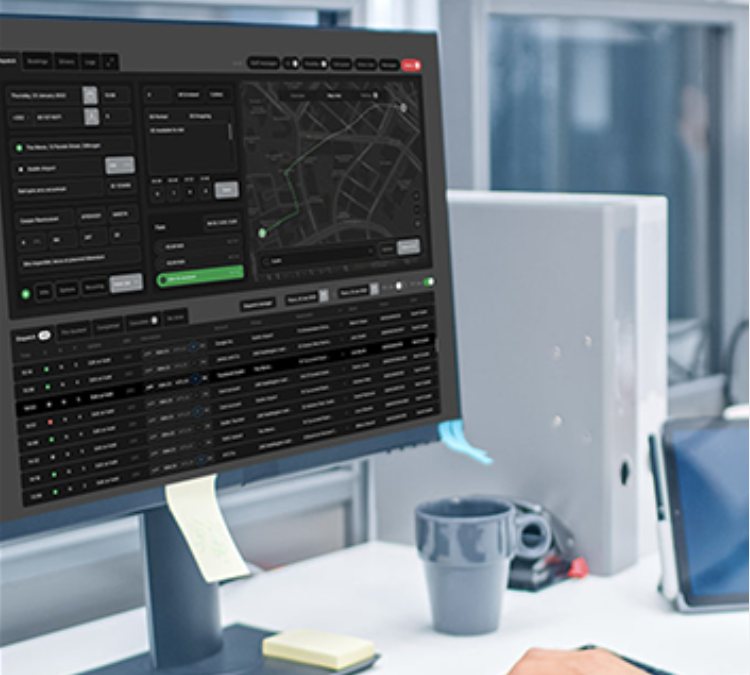The answer is simple: NEMT software. Here’s why:
- By automating time-consuming tasks, you can reduce payroll costs and save money. Think about what your team could achieve with less time on manual tasks and more focus on growing your business.
- You’ll further reduce costs by using NEMT software to optimize route planning, leading to enhanced vehicle utilization. Better multi-loading of passengers and fewer vehicles required to do the same amount of NEMT trips. So, lower costs associated with driver wages, vehicle maintenance, and fuel.
- The added benefit of intelligent NEMT software is that it helps you manage service delivery by helping you ensure you get your patients to their appointments on time. It also enables you to provide accurate ETAs and reduce wait and return times, allowing you to effectively manage customer expectations and satisfaction.
Investing in the right NEMT technology gives your NEMT operation the solid foundations you need to scale. And, the very first investment you need to make is research. Understanding what NEMT software can do for your fleet management and the goals you wish to achieve by implementing new technology is critical. In this article, we will help you understand the power of NEMT software so that you can determine what features and software applications are the most important for your specific use cases.
Automation and Optimization in NEMT
Automation is critical to scaling your NEMT business. Manual processes like scheduling trips, dispatching drivers, or managing billing can save you time and resources. NEMT software can take care of these repetitive tasks, allowing you to either reduce headcount or redeploy team members into revenue-generating roles like winning more NEMT broker contracts or marketing for Private Pay trips.
There are several key ways you can automate and optimize your NEMT operation.
1. NEMT trip booking automation
Manually importing trips into your dispatch system, or indeed manually allocating them to your drivers is time-consuming and unnecessary. Use NEMT software that easily connects with your brokers through APIs to allow trips to feed-in automatically. If you take NEMT bookings from other sources, ensure you have tools like apps, web bookers, or business solutions that allow trip sources to input bookings directly.
2. Route Planning
Creating route plans manually is a big job, and of course it gets more and more complicated the larger your fleet is. Often this task falls on one or two people who spend many hours each day preparing the routes for the following day. As well as costing you money in wage bills, there is also the issue of over-reliance. One or two people become critical to how your NEMT business operates. These create single points of failure in your business. For example, John is your route-planning hero. He knows all the usual patient routes inside out, knows the road infrastructure, and knows roughly how long each journey takes. John comes down with a bad dose of pneumonia and you immediately have an operational problem. Or John demands a pay rise and you are held to ransom over your route planning! Do you have a John in your business?
There is a better scenario, where the bulk of John’s value can be delivered with intelligent NEMT software. Automated route planning software like Move AI calculates the best routes for single, grouped, or linked trips, ensuring that your drivers take the shortest, most efficient paths and have passengers in their vehicle as much as possible. So, less dead-miles. This helps you save on fuel costs, reduce vehicle wear and tear, and ensure that passengers are picked up and dropped off on time.
By optimizing routes, you can increase the number of trips your drivers complete in a day – more trips per day means more revenue without the need for additional vehicles or drivers. Imagine your drivers completing more trips every day while driving fewer miles—that’s the power of route optimization.
3. Multi-loading
This is part of effective route planning and route optimization, but important enough to call it a stand-alone feature to look out for. The most complex part of planning efficient routes relates to decisions around who can share rides depending on factors like appointment times, broker rules and passenger pick-up and drop off locations. Move AI allows you to set up all of your rules in the back end, bulk import your trips, hit the optimization button and see the best multi loaded route plans possible, in seconds. Think of all of the brain power you will save.
4. Dispatching
Having a dispatch system is important for fleets of all sizes, and there are lots of different software options out there. The basic tool kit is the dispatch system, and then a driver app or tablet for receiving instructions and reporting trip details. The dispatch system serves as your operator. So, it should be able to automatically receive bookings and then automatically send these to your drivers without manual intervention. The saying ‘runs itself’ comes to mind here, and this really can be true for your fleet if you have the right tools in place.
When it comes to driver apps, the functionality across providers ranges. Move AI uses the iCabbi driver app which is powered by Google’s real-time GPS data and has a lot of smart features and functionality. Drivers can get real-time directions directly on their driver app and use the app to start and complete trips, including the recording and reporting of signatures, pick-up and drop-off times, and mileage.
5. Communication with drivers and passengers
NEMT software can help you to communicate with drivers and passengers to ensure that journeys run smoothly. This can be leveraged to meet real business goals like reducing no-shows or cancellations, so it is worth appraising when shopping around for NEMT software providers.
Move AI has lots of useful features relating to communication. You can set up triggers to send automatic messages to your drivers or passengers helping your NEMT operation run more smoothly. For example, you can set IVR calls to send to drivers at the start of their shift so they are never late for their first pick-up. Also, you can send a check-in message to passengers to see if they still require their pick-up a day or even an hour before pick-up to reduce no shows.
6. Call-taking
Do you have a high volume of calls that you answer with live operators? Not all NEMT fleets do, but if you take calls for whatever reason – be it for passengers to book directly with you or passengers checking on arrival times or other queries, you should look for NEMT software that has automated phone solutions. IVR systems can help manage routine queries, update passengers on estimated arrival times, and allow callers to book or confirm appointments without needing an operator. Not only does this reduce labor costs, but it also speeds up response times and enhances the passenger experience by providing real-time information.
For larger fleets, call routing options within NEMT software can automatically direct specific call types to the appropriate team members or departments. This setup keeps your call-taking process organized and focused, contributing to smoother operations.
7. Billing and Claims
Accurate billing is essential if you want to keep cash flowing and avoid costly mistakes. Without accuracy, you risk delayed payments, rejected claims, and revenue losses—all of which can hold your business back. The NEMT software you choose should be connected to your broker through a direct or mediated APO integration. This makes billing easy by handling the correct billing codes automatically, saving you from manual entry errors. For Medicaid trips, having software that supports compliance checks ensures you stay within regulations, helping you avoid penalties or rejected claims. Automated billing means fewer mistakes, faster payments, and lower labor costs.
8. Reporting
You will never scale your NEMT fleet without goals. You can’t have goals without targets and you can’t have targets without the ability to track data points. Reporting dashboards in NEMT software are the cherry on top for finding the right solution for your fleet. You need to be able to understand your fleet performance at a glance by monitoring things like On-tTme Performance, no-show rates, mileage, passenger utilization, and so on, and then be able to use this data to understand how these performance metrics equate in monetary terms. You can set up automated reports that allow you to routinely track your business and set goals against them. Automated reports will give you a clear view of your progress. You will not look back.
Conclusion: Time is money. NEMT software gives you more of both.
As an NEMT provider, you understand that time is money. By adopting NEMT software, you can automate the tasks that eat up your time and cost you money in human hours, reduce costs, and focus on what matters—growing your business. In order to scale you need the right NEMT technology.
Remember, NEMT software can help you with:
- Less Manual Labor: The software handles repetitive tasks, so you can reduce labor costs.
- Fewer Mistakes: Automation minimizes human errors, so you won’t lose money correcting billing issues or rescheduling trips.
- More Efficient Operations: With optimized routes and dispatching, you save on driver payroll, fuel, and vehicle wear and tear.
Stop spending time on tasks that can be automated. Invest in NEMT software and watch your business thrive!
Want to see how Move AI can help you automate and optimize your NEMT operations? Contact us today to learn more and take the next step toward a more efficient and profitable business.




















